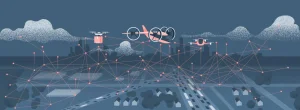- Directory
- Advanced Air Mobility White Papers
- Advanced Air Mobility (AAM)
- DEVELOPING A COMMUNICATIONS FRAMEWORK FOR ADVANCED AIR MOBILITY
DEVELOPING A COMMUNICATIONS FRAMEWORK FOR ADVANCED AIR MOBILITY
White Paper Details
Title
DEVELOPING A COMMUNICATIONS FRAMEWORK FOR ADVANCED AIR MOBILITY
Year Published
2024
Author
Paul Wheeler, Vice President of Aerial Innovation at WSP in the U.S.
PDF Download
This white paper discusses WSP's work with the state of Michigan to develop a communications framework for the state's emerging Advanced Air Mobility (AAM) ecosystem.
It highlights the importance of a robust communications network in enabling safe, efficient, and scalable AAM operations. The article also addresses how Michigan's approach to AAM infrastructure development can serve as a model for other regions looking to establish similar systems.
It highlights the importance of a robust communications network in enabling safe, efficient, and scalable AAM operations. The article also addresses how Michigan's approach to AAM infrastructure development can serve as a model for other regions looking to establish similar systems.
WSP is partnering with the Michigan Department of Transportation (MDOT) to advance a communications framework for Michigan's AAM ecosystem.
The primary objectives are:
The primary objectives are:
- Evaluating the efficacy of a short-range communications mesh in facilitating beyond visual line-of-sight uncrewed aircraft system (UAS) deployments
- Utilizing this technology to improve communication and integration between various transportation modes (buses, trains, AAM aircraft)
A robust communications framework is key to the success of AAM operations:
- Enabling seamless coordination between numerous aerial vehicles operating nearby
- Facilitating low-latency data exchange for real-time updates on travel times, vehicle locations, weather conditions, etc.
- Providing an efficient traffic management system for advisories and communications
- Enhancing situational awareness for both crewed and uncrewed vehicles
- Allowing quick emergency response communication
- Integrating with existing aviation and air traffic control systems
- Linking various transportation modes to mitigate congestion
Challenges in implementing and maintaining an AAM communications framework include:
- Need for redundancy and failsafe systems to ensure safety
- Interoperability issues between components from different manufacturers
- Security and data privacy concerns
- Scalability to accommodate a growing number and diversity of vehicles
- Maintaining low-latency communication with large data packets
- Adapting to evolving regulations and standards
Michigan's approach, which can be a model for other regions, involves:
- Strong leadership support and coordination across state government
- Proactive engagement with the FAA to harmonize state and federal regulations
- The phased approach to technology integration, testing the feasibility of critical components
- Commitment to improving community well-being as a core principle
Login To Download:
User reviews
There are no user reviews for this listing.
Already have an account? Log in now or Create an account
